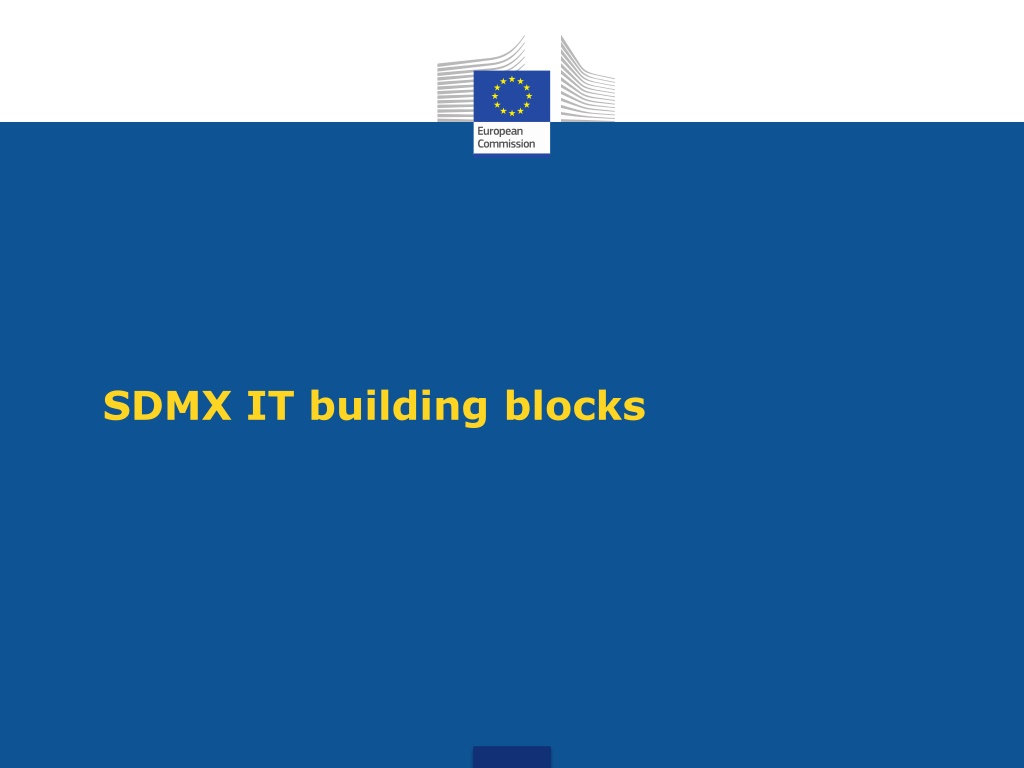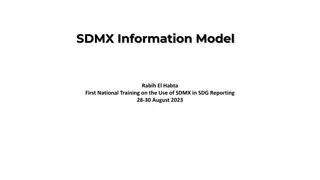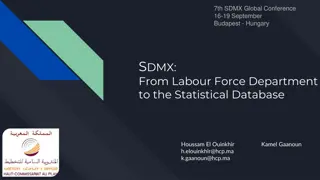Understanding SDMX Implementation Scenarios and IT Architectures
SDMX is commonly used for data reporting at the national level, with various scenarios like Push, Pull, and Hub modes. Push Mode offers lightweight and industrial approaches using tools like SDMX Converters and SDMX-RI. These tools help in converting native files into the desired SDMX format and extracting information from databases for SDMX reporting.
Download Presentation

Please find below an Image/Link to download the presentation.
The content on the website is provided AS IS for your information and personal use only. It may not be sold, licensed, or shared on other websites without obtaining consent from the author. Download presentation by click this link. If you encounter any issues during the download, it is possible that the publisher has removed the file from their server.
E N D
Presentation Transcript
SDMX for data reporting Data reporting is the most common SDMX implementation scenario at national level: data providers are asked to provide data to international organisations according to SDMX specifications. There are three main different scenarios for data reporting, and each scenario implies a different IT architecture: Push mode Pull mode Hub mode
Push Mode 1 2 3 PUSH PREPARE
Push mode: option 1 lightweight approach The NSI only needs a Converter tool to convert its native files in the desired SDMX format, using the DSD provided by the agency it needs to report to. DSD Local Application/ Manual generation SDMX Converter SDMX File Non SDMX File
Format Converters SDMX Converter (Eurostat) Excel2SDMX (ISTAT) Fusion Transformer (Command Line Interface only) SMART (ILO)
Push mode: option 2 industrial approach The SDMX-RI is a DB Mapping suite conecting directly to the native database is recommended. The provided by the data receiver with the information in the database, and to extract it in an SDMX format. SDMX-RI helps map the DSD DSD SDMX-RI Send to data consumer SDMX File
SDMX-RI architecture - Mapping Assistant maps Legacy DB structure to DSD Legacy database - SDMX-compliant service data by retrieving them from the database and applying the mappings Mapping Store web SDMX returns legacy in the
DB Mapping suites SDMX-RI Suite (Eurostat): it includes the mapping assistant, Service and the NSI Test Client the SDMX-RI Web Data Manager (ISTAT): The Data Manager is a DB mapping tool made available by ISTAT. It reuses the SDMX-RI Web Service as one of its components The SDMX-RI is covered in detail in Eurostat's SDMX IT tools ESTP course!
Pull Mode 3 2 1 PULL 4 PREPARE
Pull Mode The Pull Mode requires NSIs to expose their data via web services using a DB Mapping suite, and to set up a registration with te SDMX registry used by the interested international organisation(s). SDMX Registry 2 3 SDMX-RI International Organisation PULL 4 1 PREPARE
Hub Mode 2 1 3 PREPARE SEND 4
How Hub works National Statistical Institute National Statistical Institute Eurostat Census Hub Architecture needed on NSI side same as in Pull mode
SDMX for data dissemination SDMX can also be used as a basis for a public dissemination infrastructure for statistics. Such a use case has been implemented in e.g. Eurostat or ISTAT. The architecture needed for this is similar to the one used for the Pull mechanism or Hub. However, in addition to a DB Mapping Suite, two additional elements are needed: The NSI needs an SDMX Registry to manage and store the objects (e.g. DSDs) needed for dissemination (this is not needed for reporting, as the structures international organisations) The architecture should include a visualidation tool (Data Browser) for users are provided to the NSIs by
SDMX for data dissemination SDMX Registry DSD, Codelists, etc Visualisation tool (Data Browser) SDMX-RI
SDMX Registry Euro-SDMX Registry (Eurostat) Fusion Registry (Metadata technologies): Community Edition (free) and Enterprise edition (subscription service) Meta Manager (ISTAT)
Visualisation tools SDMX-RI Web Client (Eurostat) Web data Browser (ISTAT)
SDMX for data science This use case focuses on using SDMX data for analysis and research. The organisations mainly applying this use cases are universities / research institutes, but NSIs that also have a focus on the analysis or international comparison of data can be interested as well. This use case relies on the use of visualisation and analysis tools (mostly connectors) to query SDMX registries via the standards SDMX web services. data sources and SDMX
SDMX for data science SDMX Registry Data analysis tools (connectors) SDMX Data web services
Data Analysis tools / SDMX Connectors Excel: ILOSTAT Excel Add-in (ILO), Fusion XL (Metadata Technologies) R: rsdmx, readsdmx, RJSDMX packages Python: pandaSDMX package JAVA / MATLAB / SAS: SDMX connectors by Banca d'Italia
SDMX Tools List of available SDMX tools on SDMX.org: https://sdmx.org/?page_id=4500 What do they all do?
- Many SDMX tools are available, and many of them are open source and free - Different SDMX tools offer different capabilities. The capabilities and architecture you need depends on the specific use case you are interested in - Many solutions are available for each major component / capability 26 Eurosta t























